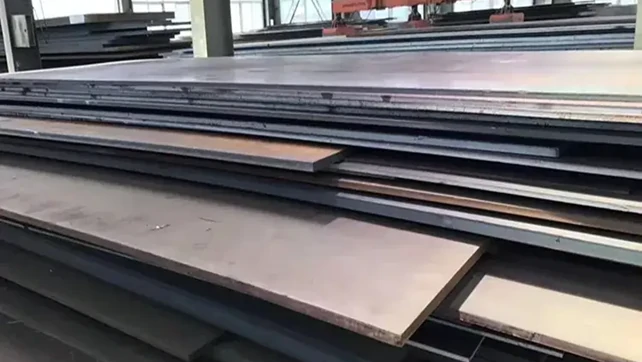South Korea has imposed provisional anti-dumping duties on hot-rolled carbon steel sheets and coils from China
South Korea has imposed provisional anti-dumping duties on hot-rolled carbon steel sheets and coils from China, with the maximum duty rate reaching up to 33.10%.China's steel export pattern is undergoing profound changes, and carbon steel products face both challenges and opportunities in the international market.
Sep 24,2025

01 Details of South Korea's anti-dumping Measures on Carbon Steel
South Korea's current anti-dumping investigation began on March 4, 2025, and the dumping investigation period of the case is from July 1, 2023 to June 30, 2024. After an investigation, the Korea Trade Commission made a positive preliminary ruling on July 24, 2025, which ultimately led to the implementation of the provisional anti-dumping duty.
According to the official announcement, the provisional anti-dumping duty rates for Chinese enterprises are as follows: 29.89% for Baoshan Iron & Steel Co., Ltd. and its affiliated enterprises, and 28.16% for Benxi Steel Plate Co., Ltd. and its affiliated enterprises. Several other Chinese traders and unnamed producers/exporters are all subject to a tax rate of 33.10%.
This measure involves a wide range of products, covering various carbon steel and alloy steel hot-rolled plates and coils under South Korean tariff codes 7208, 7211 and 7225. However, hot-rolled steel plates with a thickness of 4.75 millimeters or more and a width of 600 millimeters or more, as well as three types of products such as coated and plated ones, are excluded.
02 A wave of global trade protection is surging
South Korea is not the only country that has imposed restrictions on Chinese carbon steel products. On August 25, 2025, the US Department of Commerce made a final ruling on the second sunset review of anti-dumping duties on carbon steel alloy wire rods imported from China, maintaining the anti-dumping duty at 110.25%.
Since 2025, the number of anti-dumping investigations into China's steel exports has been on the rise. According to the analysis of C1 Energy, global trade frictions and the increase in related taxes and fees will gradually restrain China's steel exports.
Trade protection measures mainly focus on finished steel products such as hot-rolled plates and coils, medium and heavy plates, and seamless steel pipes. These products are precisely the main varieties of China's steel exports and have strong price competitiveness in the international market.
03 The export pattern of China's carbon steel has changed
In the face of anti-dumping measures from many countries, China's carbon steel export pattern is proactively adjusting. According to data from C1 Energy, China's steel exports increased by 10.0% year-on-year from January to August 2025, and the export volume of steel billets rose significantly by 293.24% year-on-year.
The distribution of export areas has shown obvious changes. China's total steel exports to Vietnam and South Korea have declined, while imports to regions such as Africa and South America have risen significantly. The volume of steel imported from China by ASEAN countries such as Thailand, the Philippines and Myanmar has significantly increased. From January to August, China's overall exports to Southeast Asia rose slightly by 300,000 tons.
With the continuous advancement of infrastructure projects in Saudi Arabia, Egypt, the United Arab Emirates and other countries, the Middle East region's reliance on Chinese steel has generally been on the rise.
Steel billets, as semi-finished products, enjoy the policy dividend of almost zero tariffs and have become a new growth point for exports. From January to August, the total volume of domestic billet exports was 9.2362 million tons, mainly exported to countries such as Indonesia, the Philippines, and Saudi Arabia.
04 Breakthroughs in high-end products and market Diversification
While dealing with trade barriers, Chinese steel enterprises are actively promoting product upgrading and market diversification strategies. The Zhoukou base of Henan Iron and Steel Group successfully rolled out Q345RZ35 high-end container plates and successfully exported them for application in the Bodhisattva Hydropower Station Project in Cambodia in Southeast Asia.
This breakthrough fills the gap in high-end container steel in Henan Province's steel industry and marks the progress made by Chinese steel enterprises in the field of high value-added products. High-end container plates feature Z35 grade thickness direction performance, ensuring that the steel plates are less prone to layered tearing when subjected to high pressure.
China's steel industry has developed into the most complete steel industrial system and is capable of producing the richest variety of steel products. Its competitive strength in multiple aspects such as variety, quality and logistics has been significantly enhanced, providing effective support for the project construction demands of neighboring countries.
05 Industry Response and Future Outlook
In response to the increasing number of trade remedy measures, Chinese steel enterprises are seeking breakthroughs in multiple dimensions. On the one hand, through the "price-for-volume" model, the price advantage of domestic steel exports is utilized to offset the high tariff costs. On the other hand, actively adjust the structure of export products and increase the export of semi-finished products such as steel billets.
Some enterprises maintain market access by accepting price commitments. In the anti-dumping case of Huazhong thick plates by South Korea, the price commitments made by nine Chinese exporters were accepted. These enterprises can continue to export based on the price commitments without being subject to the higher anti-dumping duty rates.
Looking ahead, C1 Energy's analysis suggests that China's steel exports may remain at a high level in the fourth quarter. However, due to the relatively high base of exports last year, the year-on-year growth rate may still face downward pressure. If the export of steel and billets continues at the average export level from June to August, the total export volume of steel and billets for the whole year could reach 130 million tons, an increase of approximately 14 million tons year-on-year.
With the latest anti-dumping measures taken by South Korea coming into effect, China's exports of hot-rolled carbon steel sheets and coils to South Korea will face short-term challenges. However, Chinese steel enterprises are actively responding through measures such as market diversification, product high-endization and adjustment of export structure.
The global manufacturing industry is in a weak recovery trend. The global manufacturing PMI in August was 49.9%, up 0.6 percentage points from the previous month, approaching the 50% boom-bust line. The gradual improvement of this external environment may offer new opportunities for China's steel exports.
PREVIOUS:



